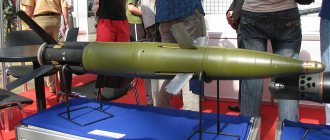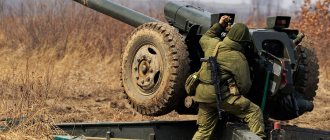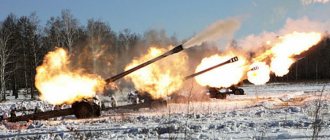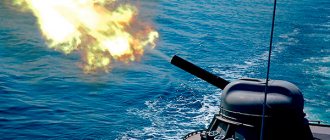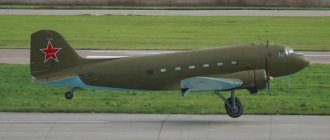3OF39 "Krasnopol"
"Krasnopol" - adjustable artillery ammunition of 152 or 155 mm caliber. Designed to hit armored targets and military installations with the first shot. The correction is carried out by aerodynamic control surfaces at the final stage of the flight according to the laser mark on the target. To increase the firing range, the projectile has a jet engine or a bottom gas generator. Developed aerodynamic surfaces provide planning to the target, increasing range and reducing cloud height restrictions. It is part of the Russian guided artillery weapon system, developed at the Tula Instrument Design Bureau. Export versions of the projectile are adapted to the corresponding systems of importing countries.
Serial production is carried out by Izhmash OJSC; the homing head (GOS) for the projectile is manufactured by LOMO.
Work on the creation of a guided 152-mm artillery projectile "Krasnopol" began in the late 1970s at KBP. The laser semi-active homing head for the projectile was developed by the Leningrad Optical-Mechanical Association, the production of the seeker was carried out by the Progress Research and Production Complex (now NVK Progress, Nezhin, Ukraine), the laser target designator-rangefinder 1D15 (or 1D20) was created by the Polyus Research Institute " On-board equipment - NIIFP.
Description
The Russian guided weapon system (GRAU index 2K25) includes a 3OF39 Krasnopol adjustable high-explosive fragmentation projectile of 152 mm caliber (used as part of the 3VOF64 and 3VOF93 separate-loading rounds), with a semi-active laser homing head 9E421, which receives a reflected signal from an illuminated target laser target designator-rangefinder 1D15 (1D20, 1D22). The complex may include a set of 1A35 shot synchronization tools and an R-159M radio station. Firing is carried out from Russian 152-mm artillery systems: D20, 2S3M Akatsiya, 2S19 Msta-S, 2A65 Msta-B.
For stowing in the fighting compartment of self-propelled guns, the 3OF39 projectile is structurally designed in the form of two compartments, joined before firing using a quick-screw connection:
— a projectile compartment, which includes a warhead (warhead), an accelerating engine (solid propellant motor) and a stabilizer unit; — control compartment, including the autopilot unit, seeker and nose unit.
Four retractable aerodynamic rudders are used as controls for the projectile in flight; the stabilizer block also has four retractable stabilizers.
The modified version 3OF39M is made as a monoblock, which simplifies preparation for shooting.
Friction bearings on the driving belts ensure low rotation speed of the projectile when fired from a standard rifled gun barrel. This is necessary for the normal operation of correction systems. To increase the charge, the ammunition body is made thin-walled. Maintaining the body geometry during overloads at the moment of firing is ensured by redistribution of the boost pressure of the powder gases. The optics of the homing head are covered with a protective casing (to protect against contamination and damage), which can be separated in flight.
3OF39M "Krasnopol-M"
3OF39M "Krasnopol-M" - monoblock modification of 3OF39 "Krasnopol". The ammunition is made in the overall dimensions and weight characteristics of a conventional unguided OFS, which allows it to be placed in assembled form (without dividing into compartments) as part of the standard ammunition rack of self-propelled guns. In the UAS "Krasnopol-M", to achieve maximum firing range, instead of the accelerating engine of the UAS "Krasnopol", a bottom gas generator was used, which made it possible to reduce the length of the projectile. The number of retractable stabilizers has been increased to 6 pieces. Development has been underway since the 1990s.
Due to the possibility of firing along a flatter trajectory compared to the basic version, the requirements for the minimum height of the cloud limit have been reduced for Krasnopol-M. As a result, the time favorable for the use of Krasnopol-M increased by 10-30% (depending on the theater of operations). It has a higher probability of hitting the target - 0.8-0.9 (0.7-0.8 for 3OF39 "Krasnopol").
Krasnopol-M2 at the MVSV-2008 exhibition
Guided projectile Krasnopol. TTX. Firing range. Dimensions. Price
3OF39 "Krasnopol"
"Krasnopol" - adjustable artillery ammunition of 152 or 155 mm caliber. Designed to hit armored targets and military installations with the first shot. The correction is carried out by aerodynamic control surfaces at the final stage of the flight according to the laser mark on the target. To increase the firing range, the projectile has a jet engine or a bottom gas generator. Developed aerodynamic surfaces provide planning to the target, increasing range and reducing cloud height restrictions. It is part of the Russian guided artillery weapon system, developed at the Tula Instrument Design Bureau. Export versions of the projectile are adapted to the corresponding systems of importing countries.
Serial production is carried out by Izhmash OJSC; the homing head (GOS) for the projectile is manufactured by LOMO.
Work on the creation of a guided 152-mm artillery projectile "Krasnopol" began in the late 1970s at KBP. The laser semi-active homing head for the projectile was developed by the Leningrad Optical-Mechanical Association, the production of the seeker was carried out by the Progress Research and Production Complex (now NVK Progress, Nezhin, Ukraine), the laser target designator-rangefinder 1D15 (or 1D20) was created by the Polyus Research Institute " On-board equipment - NIIFP.
Description
The Russian guided weapon system (GRAU index 2K25) includes a 3OF39 Krasnopol adjustable high-explosive fragmentation projectile of 152 mm caliber (used as part of the 3VOF64 and 3VOF93 separate-loading rounds), with a semi-active laser homing head 9E421, which receives a reflected signal from an illuminated target laser target designator-rangefinder 1D15 (1D20, 1D22). The complex may include a set of 1A35 shot synchronization tools and an R-159M radio station. Firing is carried out from Russian 152-mm artillery systems: D20, 2S3M Akatsiya, 2S19 Msta-S, 2A65 Msta-B.
For stowing in the fighting compartment of self-propelled guns, the 3OF39 projectile is structurally designed in the form of two compartments, joined before firing using a quick-screw connection:
— a projectile compartment, which includes a warhead (warhead), an accelerating engine (solid propellant motor) and a stabilizer unit; — control compartment, including the autopilot unit, seeker and nose unit.
Four retractable aerodynamic rudders are used as controls for the projectile in flight; the stabilizer block also has four retractable stabilizers.
The modified version 3OF39M is made as a monoblock, which simplifies preparation for shooting.
Friction bearings on the driving belts ensure low rotation speed of the projectile when fired from a standard rifled gun barrel. This is necessary for the normal operation of correction systems. To increase the charge, the ammunition body is made thin-walled. Maintaining the body geometry during overloads at the moment of firing is ensured by redistribution of the boost pressure of the powder gases. The optics of the homing head are covered with a protective casing (to protect against contamination and damage), which can be separated in flight.
KM-2 "Krasnopol-M2"
155-mm version of the Krasnopol-M guided artillery projectile (to NATO standards). Includes an adjustable high-explosive fragmentation projectile K155M of 155 mm caliber, with semi-active homing to a target illuminated by a laser. Designed to destroy stationary and moving armored and unarmored targets and engineering structures at a distance of up to 25 km, with the first shot. The method of destruction is from above, along a takeoff-dive trajectory.
Supplied to India and China, produced under license in China. For the Krasnopol-M complex, CILAS (France) developed a laser target designation system DHY307; in 2001, to confirm its compatibility with Krasnopol, firing tests using DHY307 were carried out in France.
Electronic fuses
A promising direction for improving serial ammunition today is the replacement of mechanical fuses with electronic (“digital”) ones. At the same time, all other components of the rocket are preserved. Such a measure, of course, does not transform a projectile flying along a ballistic trajectory into a correctable one. But it can significantly increase its lethality when operating against a number of typical targets on the battlefield.
The essence of the novelty is that the electronic fuse is made on the basis of a miniature computing device (computer board). It processes data coming from remote external devices via a special dedicated information transmission channel. The creation of such systems became possible thanks to the latest achievements of scientific and technological progress. The introduction of miniature computer boards makes possible the so-called “non-contact” loading of data into a projectile immediately before firing. A simple way is to use an “induction line”. There are also more technologically advanced solutions.
The use of electronic fuses makes it possible to detonate the warhead of a projectile at the optimal distance from the target so that it is covered by a stream of fragments. This increases the likelihood of destroying the target. Similar schemes have already been implemented by the Russian industry in relation to shells for 125 mm tank guns. In addition, work is actively underway around the world to introduce electronic fuses into artillery systems, especially howitzers of 152-155 mm caliber.
Let us recall that “traditionally” NARs are equipped with a remote fuse, which detonates the warhead at a given distance (according to the duration of the flight), or a contact fuse, which is triggered upon contact. Radio fuses are also used, initiating the detonation of warheads at a given height from the earth's surface. In our opinion, replacing them with electronic fuses is a matter of time.
Krasnopol-D
Further modernization of the Krasnopol projectile with increased firing range and guidance using satellite navigation.
Application
A crew of three people illuminates the target using a laser target designator-rangefinder, which is part of the Malachite portable automated fire control system. Small targets such as a tank can be illuminated at a distance of up to 5-7 kilometers during the day and 4 km at night, larger targets - up to 15 km. After which a guided artillery shell is fired from a distant position.
Combat use
- Russian military operation in Syria - the Krasnopol shell eliminated militants who fired at the Khmeimim airfield on December 31, 2017. - Armed conflict in eastern Ukraine - in June 2022, in the combat zone in Ukraine, military personnel of the Ukrainian Armed Forces discovered the remains of an accelerating engine and stabilizers similar to the tail section of the Soviet modification of the Krasnopol projectile or its Ukrainian copy of the Kvitnik. Ukrainian media have suggested the supply of these ammunition from Russia.
Export
India - 3,000 Krasnopol-M units delivered from 1999 to 2002. The total amount of supplies amounted to about 111 million US dollars;
PRC - at least 1000 152-mm Krasnopol-M shells were supplied in 1999-2000, also since March 2000 under a license acquired by the PRC in 1997 by Norinco.
Tactical and technical characteristics of the Krasnopol projectile
— Designer: KBP — Manufacturer: Izhmash — Options: 3OF39, 3OF39M, K155, K155M
Cost of the Krasnopol projectile
— 70,000 USD
Projectile weight Krasnopol
— Weight: 3ОФ39 — 50.8 kg. 3OF39M - 45 kg. K155 - 51.3 kg. K155M - 54 kg
Dimensions of the Krasnopol projectile
— Length: 3ОФ39 — 1305 mm. 3OF39M - 960 mm. K155 - 1300 mm. K155M - 1200 mm - Caliber: 3OF39/3OF39M - 152 mm. K155/K155M - 155 mm
Firing range of the Krasnopol projectile
- Sighting range: 3000 - 20,000 m - Maximum range: 3OF39M - 25,000 m. K155 - 22,000 m. K155M - 25,000 m - Weight of explosive: 3OF39 - 6.5 kg. 3OF39M - 10 kg. K155 - 6.3 kg. K155M - 11 kg
Similar
SAU 2S7 Pion (2S7M Malka) performance characteristics. Caliber. Dimensions. Firing range
MLRS BM-21 Grad. Damage area. Rockets. Caliber. Story
120-mm mortar 2B11 complex 2S12 Sani TTX. Firing range. Weight
Mortar 2B9M Vasilek 82 mm Rate of fire. Firing range. Weight
Self-propelled gun 2S3 Akatsiya 152 mm. Firing range. Dimensions. Weight. Engine
SAU 2S1 Gvozdika 122 mm Firing range. Dimensions. Device. Weight
Gun 2A36 Giatsint-B 152 mm. Firing range. Dimensions. Device
MLRS 9K58 Smerch Damage area. Rockets. Caliber. Story
MT-12 Rapier gun. Firing range. Story. Dimensions
Howitzer D-30 122-mm performance characteristics. Firing range. Dimensions. Weight
2S4 Tulip self-propelled mortar 240 mm performance characteristics. Dimensions. Firing range. Weight
Self-propelled gun 2S35 Koalitsiya-SV 152-mm performance characteristics. Firing range. Dimensions. Weight
Howitzer Msta-B (2A65) 152 mm. Firing range. Dimensions. Weight. Ammunition
Self-propelled gun 2S9 Nona-S 120 mm performance characteristics. Firing range. Dimensions. Weight. Armament
AT-T heavy artillery tractor. TTX. Dimensions. Engine. Story
SAU 2S19 Msta-S 152 mm Dimensions. Speed. Engine. Story
MLRS 9K57 Hurricane Damage area. Rockets. Caliber. Story
TOS-1 Buratino (TOS-1A Solntsepek) performance characteristics. Damage area
Divisional gun ZIS-3 76 mm. TTX. Firing range. Dimensions. Weight
Howitzer gun D-20 152 mm performance characteristics. Firing range. Dimensions. Weight
Howitzer M-30 model 1938 122-mm performance characteristics. Firing range. Dimensions. Weight
Self-propelled gun 2S5 Giatsint-S 152 mm performance characteristics. Firing range. Armament. Dimensions. Weight
Self-propelled gun Ferdinand (Elephant) performance characteristics. Reservation. Weight. Dimensions
Self-propelled gun SU-100. TTX. Armament. Dimensions. Shells. Weight. Speed
Self-propelled gun Sturmtiger caliber 380 mm. TTX. Armament. Shells. Reservation. Dimensions
203-mm howitzer B-4 model 1931 performance characteristics. Weight. Ammunition. Dimensions
Self-propelled gun SU-152 St. John's wort 152 mm performance characteristics. Shells. Firing range. Dimensions. Weight
Gun M-46 130-mm performance characteristics. Firing range. Dimensions. Weight
Demining installation UR-77 Meteorite TTX. Armament. Dimensions
MLRS 9K51M Tornado-G. Rockets. TTX. Firing range. Dimensions
SAU 2S31 Vienna 120 mm. Firing range. Story. Dimensions. Weight
German self-propelled gun StuG III. Modifications. Dimensions. Armament. Weight
Guided projectile Krasnopol. TTX. Firing range. Dimensions. Price
Mortar Karl 600 mm and 540 mm performance characteristics. Firing range. Weight. Dimensions
Big Bertha 420 mm gun. TTX. Weight. Dimensions. Ammunition
Self-propelled gun SU-76. TTX. Dimensions. Reservation. Weight. Story
SAU 2S23 Nona-SVK 120-mm performance characteristics. Armament. Range and accuracy of fire. Dimensions
SAU 2A3 Condenser-2P caliber 406 mm Firing range. Armament. Dimensions. Weight
Mortar M-160 caliber 160-mm performance characteristics. Firing range. Ammunition. Dimensions
Airborne self-propelled gun ASU-57. Armament. TTX. Dimensions. Weight. Booking
Artillery complex A-222 Bereg 130 mm. TTX. Firing range. Ammunition
Howitzer BR-18 caliber 305 mm TTX. Firing range. Weight
152 mm howitzer D-1. Firing range. Dimensions. Weight. Device
Mortar M-240 caliber 240 mm. Firing range. Dimensions. Weight
Self-propelled gun SU-85. Ammunition. Reservation. Dimensions. Weight. Engine
Counter-battery radar Zoo-1 (1L219M). Range of control of firing positions. Device
SAU 2S25 Sprut-SD. Caliber. Story. Dimensions. Weight. Engine
Self-propelled gun 2S34 Hosta 120 mm. TTX. Dimensions. Firing range. Armament. Weight
Self-propelled gun ASU-85. Armament. Dimensions. Reservation. Weight
280-mm mortar Br-5 model 1939 Dimensions. Weight. Ammunition
Self-propelled gun 2A45M Sprut-B. TTX. Speed. Engine. Weight
Belarusian MLRS BelGrad. TTX. Firing range. Ammunition. Dimensions
S-23 cannon 180 mm caliber. Ammunition. Weight. Dimensions. Firing range
Self-propelled gun SAU SU-122. Dimensions. Armament. Reservation. Weight
Self-propelled gun Jagdpanther. Weight. Reservation. Dimensions. Armament
Multi-barreled self-propelled gun M50 Ontos. TTX. Armament. Dimensions. Booking
D-74 cannon 122 mm caliber. Firing range. Dimensions. Weight
Artillery tractor YA-12. Dimensions. Weight. Load capacity. Engine
Artillery tractor T-20 Komsomolets. Armament. Reservation. Dimensions. Weight
SAU ISU-122. Armament. Dimensions. Weight. Booking
RPU-14 (8U38) - rocket launcher
MLRS BM-24 (T) 240 mm. Firing range. Dimensions. Weight. Engine
2K32 Deva - 82-mm self-propelled mortar system
Artillery tractor Comintern. Load capacity. Dimensions. Weight. Engine
Self-propelled gun SU-122-54. Reservation. Dimensions. Weight. Firing range
MLRS BM-14-16. Armament. Dimensions. Weight. Firing range
Self-propelled gun Nashorn (Rhinoceros). Armament. Dimensions. Weight. Booking
BR-2 gun caliber 152 mm. Firing range. Dimensions. Weight
Self-propelled howitzer self-propelled gun PzH 2000. Firing range. Dimensions. Weight
BR-17 cannon 210 mm caliber. Weight. Firing range. Rate of fire
Self-propelled gun Vespe 105 mm. Armament. Dimensions. Reservation. Weight
Wheeled self-propelled gun GAZ-68 (KSP-76). Armament. Dimensions. Weight. Engine
Self-propelled gun Brummbar 150 mm. Armament. Dimensions. Weight. Booking
Heavy self-propelled gun SU-14. Reservation. Dimensions. Weight. Engine
Self-propelled gun SU-5. Armament. Reservation. Dimensions. Weight
Self-propelled gun AT-1. Reservation. Dimensions. Weight. Engine
Self-propelled gun SU-12. Armament. Reservation. Dimensions. Weight
